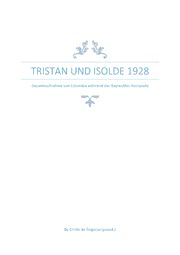
Tristan und Isolde 1928 PDF
Preview Tristan und Isolde 1928
TRISTAN UND ISOLDE 1928 Gesamtaufnahme von Columbia während der Bayreuther Festspiele By Emilio de Gogorza (pseud.) Die Gesamtaufnahme von Tristan und Isolde unter Karl Elmendorff entstand in Bayreuth 1928 mit den Sängern, die auch auf den Festspielen sangen. Sie erschein bei Columbia. Tristan und Isolde wurde 1927 wieder in die Bayreuther Festspielserie auf- genommen, nachdem die Oper zuletzt 1906 dort gespielt worden war. 1927 und 1928 wechselten sich als Tristan Gunnar Graarud und Gotthelf Pistor ab. Die Isolde wurde 1927 von Emmy Krüger, 1928 und 1930 (1929 fanden keine Festspiele statt) von Nanny Larsen-Todsen gesungen. Den König Marke sang 1927 und 1928 Ivar Andresen, 1927 alternierend mit Alexander Kipnis, 1928 mit Ludwig Hofmann. Den Kurwenal hatte Rudolf Bockelmann 1928 von Eduard Habich und Theodor Scheidl übernommen, die die Rolle 1927 sangen. 1 Gunnar Graarud als Tristan 1928 2 Anny Helm als Brangäne Bayreuth 1928-193 1 Nanny Larsen Todsen, here as Brünndhilde, as I have no phot o of her as Isolde 3 Für die Schallplattenaufnahmen mussten einige Striche hingenommen werden, um das ganze Werk auf 20 Platten zu bekommen. Besonders schmerzhaft sind diese im 3. Akt. Die große Schmerzensszene des Tristan ist sehr zusammengestrichen, was angesichts der guten Leistung von Gunnar Graarud sehr schade ist. Trotzdem ist die Aufnahme ein faszinierendes Dokument und auch künstlerisch sehr befriedigend. TRISTAN UND ISOLDE Tristan – Gunnar Graarud Isolde – Nanny Larsen-Todsen Brangäne – Anny Helm Kurwenal – Rudolf Bockelmann König Marke – Ivar Andresen Melot – Joachim Sattler Ein Hirt – Hans Beer Ein junger Seemann – Gustav Rodin Chor und Orchester der Bayreuther Festspiele, Ltg. Karl Elmendorff Columbia GOX 10532 bis GOX 10551 bzw. L 2187 bis L 2206 Aufgenommen Juli 1928 in Bayreuth Playlist: 1. Aufzug Vorspiel (Nr. 1) 1. Szene: Westwärts schweift der Blick…Entartet Geschlecht (Nr. 2-4) 2. Szene: Frisch weht der Wind…Darf ich die Antwort sagen (Nr. 5-7, Score cut after 5) 3. Szene: Weh, ach wehe! Dies zu dulden (Nr. 8 - 15, Score cut after 11 and 15) 4.Szene (cut) 5. Szene: Vorpiel (Nr. 16), Begehrt, Herrin, was ihr wünscht (Nr. 17 – 25) 2. Aufzug Vorspiel (Nr. 26) 1. Szene: Hörst du sie noch…Dein Werk, o tör’ge Magd (Nr. 27 – 31, score cut after 30) 2. Szene: Isolde, Geliebte!...Einsam wachend…Soll ich lauschen? (Nr. 32 – 43, cut after 42) 3. Szene: Rette dich, Tristan…Tatest du’s wirklich (Nr. 44 – 50, score cut after 44) 3.Aufzug Vorspiel (Nr. 51) 1. Szene: Hirtenweise…Kurwenal, sag (Nr. 52 – 53) (Large Score cut) 1. Szene: Das Schiff, siehst du’s noch nicht? (Nr. 54 – 55, score cut after 55) 2. Szene (cut): So bange Tage (Nr. 56) 3. Szene (cut): Tot denn alles…Mild und leise (Nr. 57 – 58) 4 English: Tristan and Isolde from Bayreuth in 1928. It is sung by the singers, who were active in Bayreuth in this year. Tristan and Isolde was given again in Bayreuth since 1927 after a gap of 21 years. Emmy Krüger was Isolde in 1927, Nanny Larsen-Todsen in 1928 and 1930 (in 1929 there were no Festspiele in Bayreuth). King Marke was given 1927 and 1928 by Ivar Andresen, who alternated with Alexander Kipnis in 1927 and Ludwig Hoffmann in 1928. Kurwenal was sung by Rudolf Bockelmann in 1928, while the year before Eduard Habich and Theodor Scheidl had alternated in this role. It is a pity that there are big cuts mainly in the third act, as I like the Tristan of Gunnar Graarud very much. 5 Karl Elmendorff As I didn’t have a photo of Ivar Andesen from the time of the recording, here are two photos from later Bayreuth appearances in 1934. Andresen sang until 1936 in Bayreuth (then he was 40 years old) and died just four years later. Bayreuth 1934 - from left: Ivar Andresen, Kirsten Flagstad, unknown, KirstenFlagstad's mother, Andresen's son 6 Kirsten Flagstad and Ivar Andresen Bayreuth 1934 7 Ernest Newman In the 1928 Tristan set were two sides with commentary by Ernest Newman (1868 – 1959), a music critic and musicologist, who was well known in England and had much influence as a critic. He visited Bayreuth regularly and wrote about it. Also he wrote a biography of Richard Wagner in four volumes. You can read about him in the Wikipedia article: http://en.wikipedia.org/wiki/Ernest_Newman Tristan 1928, side 15 8 Tristan 1928, side 33 The name of the records, which were sides 15 and 33 in (the English version of) the set, are: "The motives and their function in the opera, explained and illustrated by Ernest Newman", part one and two. Matrix Nrs. WAX 4276-4277 (Records L 2194, L 2203) Ernest Newman tells about the motives of the opera and gives examples on the piano – quite interesting. You can listen to the sides on archive.org: https://archive.org/details/TristanLectures1Columbia https://archive.org/details/TristanLectures2Columbia 9
